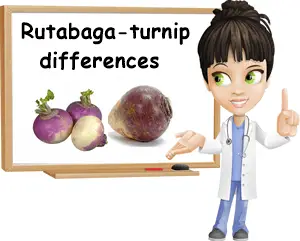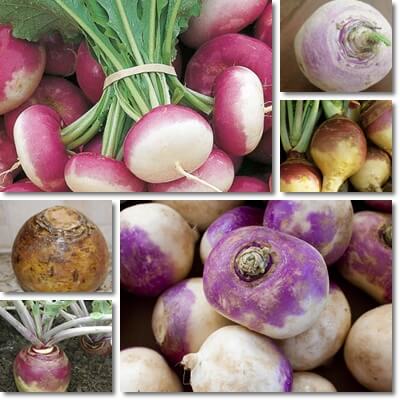Some vegetables are so similar looking that you can easily mistake one for the other. If you’ve never or rarely eaten turnips or rutabaga, you may think they are the same vegetable, especially since they look a lot alike. And they look a lot alike because one is a cross between the other and another closely related vegetable which adds to the difficulty of telling them apart. The same is true for other foods like radishes and red baby turnips which are so similar looking that some people mistake one for the other. Baby beets of the red variety also resemble radishes, while baby yellow beets look similar in appearance to round carrots. Even parsnips look like discolored carrots and jicama like potatoes, so the struggle is real. This is especially true for turnips and rutabagas which are extremely similar looking.
But how can you tell a turnip and a rutabaga apart? First of all by knowing what they are.
Both the turnip and rutabaga are root vegetables, true root vegetables actually. What this means is that the parts most commonly employed for human consumption are dominant, swollen roots that have been used by the plant to store nutrients, hence the reason they grow so large. Green and purplish stems grow directly from these roots and develop green leaves. Both the root (the underground part of the vegetables) and the stems with leaves (the part of the vegetables that grows above-ground) are edible, but because people eat the roots more than the leaves, both the turnips and rutabaga have ended up being called root vegetables.

The most important thing to know is that turnips and rutabaga are two different, yet closely related vegetables. Rutabaga is actually a cross between a turnip (Brassica rapa subsp. rapa) and a cabbage (Brassica oleracea). This explains the uncanny resemblance, shared flavor profile and even similar nutritional value. But rutabaga looks mostly like a certain variety of turnip called the white turnip, which is also the most common type of turnip. Contrary to its name, the white turnip is not always all white; most of the time it’s white with purple towards the top, which what rutabaga also looks like. Of course, there are also completely white turnip varieties, as if there wasn’t enough confusion already. Turnips and rutabagas harvested at roughly the same time look the most similar.
What is the difference between a turnip and rutabaga?
The following differences should help you better distinguish between the two vegetables:
1) Rutabagas have a rough-looking exterior, while turnips are smoother and finer-looking.
2) Commercially cultivated turnips are very often globular or slightly flattened (except for long turnip varieties that are carrot-shaped); they are harvested while still young, either the size of a radish or no larger than a baseball. The reason for an early harvest is so that the turnips retain sweet flavor notes and a pleasantly crisp, tender flesh. You should be able bite into a turnip as you would an apple, for example. Commercially available rutabagas are harvested at maturity which means the root will be larger, heavier and easier to distinguish from a turnip. And you can’t just bite into a rutabaga.
3) The most common variety of turnip is called simply turnip or white turnip, the second name referencing to its mostly white skin. Turnips can be all white or white in the lower half and reddish or purplish in the top part; the red-purple color occurs as a result of sun exposure, on the part of the turnip root that reaches above the ground. Rutabagas are actually a yellowish-brown or off-white in the lower half and a paler, dustier purplish color in the top part exposed to sunlight. If the entire root is underground, the whole rutabaga may be a yellowish-brown color. Overall, turnips look prettier while rutabagas are uglier.
4) Turnip flesh is white, while rutabaga flesh is more of a cream color, similar to parsnip or celeriac.

5) Another difference between turnips and rutabaga is taste. Younger turnips are tender, crisp, with sweet flavor notes and only slightly peppery. You can eat them raw, with skin, either plain or with salt or with an oil and vinegar dressing. Older turnips (larger, with slightly tougher skin) are less sweet, with earthy-peppery flavor notes and are best cooked (boiled, roasted, baked, stewed etc.). Also read Properties and Benefits of Turnip. If boiled, the older roots can sometimes turn out a little too moist.
Younger rutabagas can be slightly sweet, with earthy flavors and only a faint bitter aftertaste (not peppery). Older rutabagas, which is most rutabagas available commercially, are strong-tasting, either more bitter than sweet or less bitter and somewhat sweet, with a cabbage-like scent and only slightly starchy. The older vegetable is actually reminiscent of cabbage or Brussels sprouts. Read more about the Properties and Benefits of Rutabaga. The taste of rutabaga really depends on where and how it’s been grown and time of harvest. Usually, the cooked root is slightly sweet and creamy, but pleasantly strong-flavored.
6) Nutritional differences between turnips and rutabaga. Raw turnip has 28 kcal/100 g, 8.6 g of carbohydrates, out of which 3.8 are sugars. 100 g of raw root provides 2.3 g of dietary fiber.
Raw rutabaga has 37 kcal/100 g, 6.4 g of carbohydrates, out of which 4.4 g are sugars. 100 g of raw root provides 1.8 g of dietary fiber. Both vegetables contain small amounts of most essential vitamins and minerals, no more than 10% of the recommended daily intake for an average adult on a 2.000 kcal diet for every 100 g of raw root.
Rutabaga has slightly more calcium, iron, magnesium, phosphorus, potassium and zinc, but slightly less sodium than turnip. Rutabaga also contains slightly more vitamin C, vitamin K and vitamins B1, B2, B3, B6 and B9. However, the vitamin and mineral differences between the two root vegetables are quite insignificant and so they may be considered almost equally nutritious from the point of view of micronutrient content.
Similar characteristics
Just as there are differences, there are also some similarities between the two vegetables:
1) Both are called root vegetables, but also have edible top greens.
2) They have a similar color pattern: light colored in the lower part with red-purple top part.
3) Can be eaten raw or cooked, but should be cooked if harvested late.
4) The older roots tend to become woody and develop a tougher skin and stronger taste.
5) The greens are important sources of vitamin K, known for its anti-inflammatory and blood coagulation properties.
6) Not everybody can perceive the bitterness of turnip and rutabaga the same way. Some people may find the two vegetables to be too bitter to eat, others may not find them bitter at all. This has to do with personal taste perception and is presumed to be an inherited trait.
7) Both turnips and rutabagas taste best if harvested young as well as require cold weather for better tasting roots.
